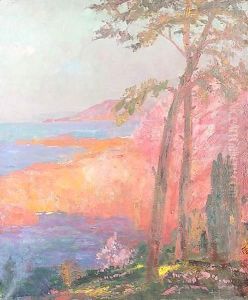Pierre Amede Marcel-Beronneau Paintings
Pierre Amédée Marcel-Béronneau was a French Symbolist painter whose work is often associated with the aesthetic and thematic trends of Symbolism and Art Nouveau at the turn of the 20th century. Born on October 9, 1869, in Bordeaux, France, Marcel-Béronneau initially pursued his artistic education locally before moving to Paris, where he further developed his skills and established his career.
Marcel-Béronneau was deeply influenced by the Symbolist movement, which emphasized emotions, ideas, and mystical themes over realistic representation. His works are characterized by their intricate detail, vibrant colors, and often feature mythological or fantastical subjects. He was particularly inspired by the works of Gustave Moreau, a pivotal figure in Symbolist art, and this influence is evident in Marcel-Béronneau’s use of exotic and erotic themes, as well as in his technique.
Throughout his career, Marcel-Béronneau exhibited his works in various salons and exhibitions, gaining recognition and accolades for his unique style. He was also involved in decorative projects, including murals and illustrations for books, showcasing his versatility as an artist. Despite his success, Marcel-Béronneau remained relatively obscure compared to his contemporaries, and his work was often overshadowed by more prominent figures of the Symbolist movement.
Marcel-Béronneau's art saw a resurgence in interest towards the end of the 20th century, as art historians and collectors began to reevaluate the contributions of lesser-known Symbolist artists. Today, his works are appreciated for their beauty and complexity, and they can be found in various private collections and museums around the world.
Pierre Amédée Marcel-Béronneau died on July 15, 1937, in Paris. His legacy lives on through his contributions to the Symbolist movement and his influence on the development of modern art, particularly in how emotions and symbolism can be powerfully conveyed through visual art.














